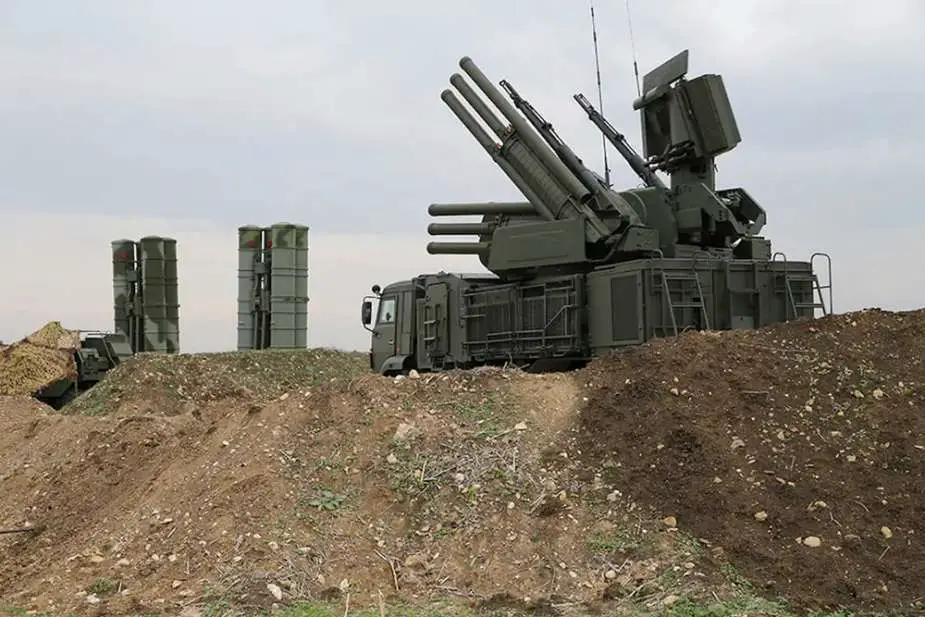Breaking news
US Intel Reveals Syria is Supplying Hezbollah with Russian Pantsir S1 Air Defense Systems.
According to information reported by CNN, International News Channel on November 2, 2023, the US has intelligence that Syrian President Bashar al-Assad has agreed to provide the Lebanese militant group Hezbollah with a Russian-made Pantsir S1 mobile air defense system, NATO designation SA-22 Greyhound.
Follow Army Recognition on Google News at this link

A Pantsir S1 SA-22 Greyhound at a Russian military base in Syria in December 2015. (Picture source Russian MoD)
Previously unreported, Assad's involvement has come to light following earlier disclosures by The Wall Street Journal regarding the potential provision of the system to Hezbollah by Wagner. Both Wagner and Hezbollah combatants have long been active in Syria, collaborating with Russian and Syrian military forces to strengthen Assad's position against opposing factions. Over time, Hezbollah has reduced its presence, yet it continues to receive support from Iran, a staunch ally of Assad. A source with knowledge of Western intelligence has indicated a growing partnership between Hezbollah and Wagner within the Syrian context.
The Pantsir-S1 (NATO reporting name SA-22 Greyhound) is a Russian-made short to medium-range surface-to-air missile and anti-aircraft artillery weapon system. The system is designed to defend against a variety of threats including fixed-wing aircraft, helicopters, drones, and precision-guided munitions.
In the context of Syria, the Pantsir-S1 systems have been a significant part of Russia's military support to the Syrian government. They have been used to protect military and strategic locations, such as airfields and command centers, from attacks by rebel and jihadist groups, as well as from potential airstrikes by other nations.
The delivery of Pantsir-S1 systems to Syria has been part of broader military and technical cooperation between Russia and the Syrian government. These deliveries have often been highlighted in the context of bilateral agreements and Russia's strategic interests in the region, including maintaining a foothold in the Mediterranean and supporting an ally in the Middle East.
The use of Pantsir-S1 systems in Syria has been reported on multiple occasions in the media, with various claims of effectiveness. There have been instances where the systems were credited with intercepting incoming threats, but also instances where they were reportedly destroyed or bypassed by enemy actions.
The Russian Pantsir-S1 is a highly mobile air defense system that combines both surface-to-air missile and anti-aircraft artillery capabilities, designed to offer point air defense of military, industrial, and administrative installations against aircraft, helicopters, precision munitions, cruise missiles, and UAVs (Unmanned Aerial Vehicles). Technically, the system is equipped with 12 57E6 or 57E6-E two-stage solid-fuel radio-command-guided surface-to-air missiles in sealed ready-to-launch containers. These missiles have a range of approximately 20 kilometers and can reach altitudes of up to 15 kilometers, with a speed of up to Mach 2.4, ensuring coverage against a variety of aerial threats. The system also includes two 2A38M 30 mm autocannons, which are effective up to 4 kilometers and can fire at a rate of up to 2,500 rounds per minute, providing a last line of defense against closer targets.
In terms of combat capabilities, the Pantsir-S1 is notable for its ability to engage multiple targets simultaneously, thanks to its modern phased-array radar systems. It can track up to 40 targets and engage up to four simultaneously with missiles. The system's radar can detect aerial targets at ranges of up to 36 kilometers and is capable of operating in passive mode to reduce the likelihood of detection. The Pantsir-S1 is also designed to be highly mobile and can be mounted on various wheeled or tracked vehicles, allowing it to keep pace with mechanized units and to reposition quickly in response to threats. Its automated control system enables rapid reaction times, typically detecting a target, identifying it, and firing a missile in a matter of seconds, which is crucial in a modern combat environment where threats can emerge and strike rapidly.
Defense News November 2023


























